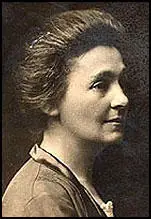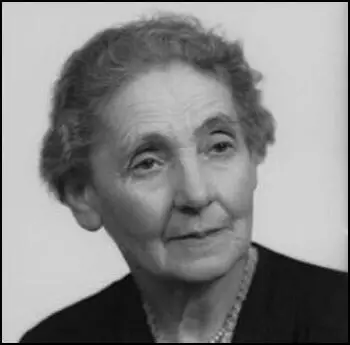Kathleen Courtney

Kathleen Courtney, the youngest of five daughters of David Charles Courtney (1845–1909), was born in Gillingham on 11th March 1878. Her father was a senior officer of the Royal Engineers.
Courtney attended the Anglo-French College in Kensington and the Manse boarding-school in Malvern before spending seven months in Dresden studying German. In January 1897 she went to Lady Margaret Hall to read modern languages (French and German). While she was at the University of Oxford, she formed a lifelong friendship with Maude Royden.
The Courtney family were extremely wealthy and never had to worry about making a living and decided to devote her life to good causes. In 1908 she was appointed secretary of the North of England Society for Women's Suffrage. One of its members, Helena Swanwick, later revealed that Courtney arrived in Manchester "with a big reputation" as an outstanding organiser. In 1911 she moved to London where she worked closely with Millicent Fawcett as honorary secretary of the National Union of Women's Suffrage Societies (NUWSS).
Herbert Asquith and his Liberal Party government still refused to support legislation. At its annual party conference in January 1912, the Labour Party passed a resolution committing itself to supporting women's suffrage. This was reflected in the fact that all Labour MPs voted for the measure at a debate in the House of Commons on 28th March. Soon afterwards Henry N. Brailsford and Kathleen Courtney, entered negotiations with the Labour Party as representatives of NUWSS.
In April 1912, the NUWSS announced that it intended to support Labour Party candidates in parliamentary by-elections. The NUWSS established an Election Fighting Fund (EFF) to support these Labour candidates. The EFF Committee, which administered the fund, included Kathleen Courtney, Margaret Ashton, Henry N. Brailsford, Muriel de la Warr, Millicent Fawcett, Catherine Marshall, Isabella Ford, Laurence Housman, Margory Lees and Ethel Annakin Snowden. The NUWSS also employed organizers such as Ada Nield Chew and Selina Cooper, who were active members of the Labour Party. Elizabeth Crawford, the author of The Suffragette Movement (1999) has argued: "Her (Kathleen Courtney) arrival at the London headquarters coincided with the implementation of the federation scheme and her organizational skills were much appreciated."
In July 1914 the NUWSS argued that Asquith's government should do everything possible to avoid a European war. Two days after the British government declared war on Germany on 4th August 1914, Millicent Fawcett declared that it was suspending all political activity until the conflict was over. Although the NUWSS supported the war effort, it did not follow the WSPU strategy of becoming involved in persuading young men to join the armed forces.
Despite pressure from members of the NUWSS, Fawcett refused to argue against the First World War. Her biographer, Ray Strachey, argued: "She stood like a rock in their path, opposing herself with all the great weight of her personal popularity and prestige to their use of the machinery and name of the union." At a Council meeting of the National Union of Women's Suffrage Societies held in February 1915, Fawcett attacked the peace efforts of people like Mary Sheepshanks. Fawcett argued that until the German armies had been driven out of France and Belgium: "I believe it is akin to treason to talk of peace."
After a stormy executive meeting in Buxton all the officers of the NUWSS (except the Treasurer) and ten members of the National Executive resigned over the decision not to support the Women's Peace Congress at the Hague. This included Kathleen Courtney, Chrystal Macmillan, Margaret Ashton, Catherine Marshall, Eleanor Rathbone and Maude Royden, the editor of the The Common Cause.
Kathleen Courtney wrote when she resigned: "I feel strongly that the most important thing at the present moment is to work, if possible on international lines for the right sort of peace settlement after the war. If I could have done this through the National Union, I need hardly say how infinitely I would have preferred it and for the sake of doing so I would gladly have sacrificed a good deal. But the Council made it quite clear that they did not wish the union to work in that way."
According to Elizabeth Crawford, the author of The Suffragette Movement (1999): "Mrs Fawcett afterwards felt particularly bitter towards Kathleen Courtney, whom she felt had been intentionally and personally wounding, and refused to effect any reconciliation, relying, as she said, on time to erase the memory of this difficult period."
In April 1915, Aletta Jacobs, a suffragist in Holland, invited suffrage members all over the world to an International Congress of Women in the Hague. Some of the women who attended included Kathleen Courtney, Mary Sheepshanks, Jane Addams, Alice Hamilton, Grace Abbott, Emily Bach, Lida Gustava Heymann, Emmeline Pethick-Lawrence, Emily Hobhouse, Chrystal Macmillan, Rosika Schwimmer. At the conference the women formed the Women's International League for Peace and Freedom (WIL). Courtney was elected as chairperson of the British section.
Courtney became a pacifist and during the First World War, Kathleen Courtney became associated with the Friends' War Victims Relief Committee. Her biographer, Janet E. Grenier, has pointed out: "She worked for the Serbian Relief Fund in Salonika, took charge of a temporary Serbian refugee colony in Bastia, Corsica, and was decorated by the Serbian government. Those who knew her during this period described her as full of life and fun and an exceptional administrator. She went on to work for the Friends' committee in France, Austria, Poland, Czechoslovakia, and Greece. She was in Vienna for three years where she was horrified by the post-war scenes of starvation, particularly among refugees."
Courtney continued to be involved in the campaign for women's suffrage. She helped establish the Adult Suffrage Society in 1916 and as joint-secretary she lobbied members of the House of Commons for extension of the franchise until the Qualification of Women Act was passed in 1918. The following year she became vice-president of the National Union of Societies for Equal Citizenship. As well as advocating the same voting rights as men, the organisation also campaigned for equal pay, fairer divorce laws and an end to the discrimination against women in the professions.
After the war she became a leading figure in the pacifist movement and was a member of the League of Nations Union and became a member of its executive in 1928. She spent much time in Geneva, working as first vice-president of the Peace and Disarmament Committee of Women's International Organizations. However, in 1933 she resigned from the Women's International League for Peace and Freedom because she believed that the league's pacifism, calling for complete disarmament, was unrealistic.

When Abyssinia was invaded by Italy in October 1935, she mobilized British and European women's organizations in the campaign to prevent civilian bombing. During the Second World War she worked for the Ministry of Information. In 1945 she attended the San Francisco conference that established the United Nations. Soon afterwards she became deputy chairman of the United Nations Association.
Kathleen Courtney died at her home, 3 Elm Tree Court on 7th December 1974. A memorial service was held on 11th April 1975 at St Martin-in-the-Fields.

